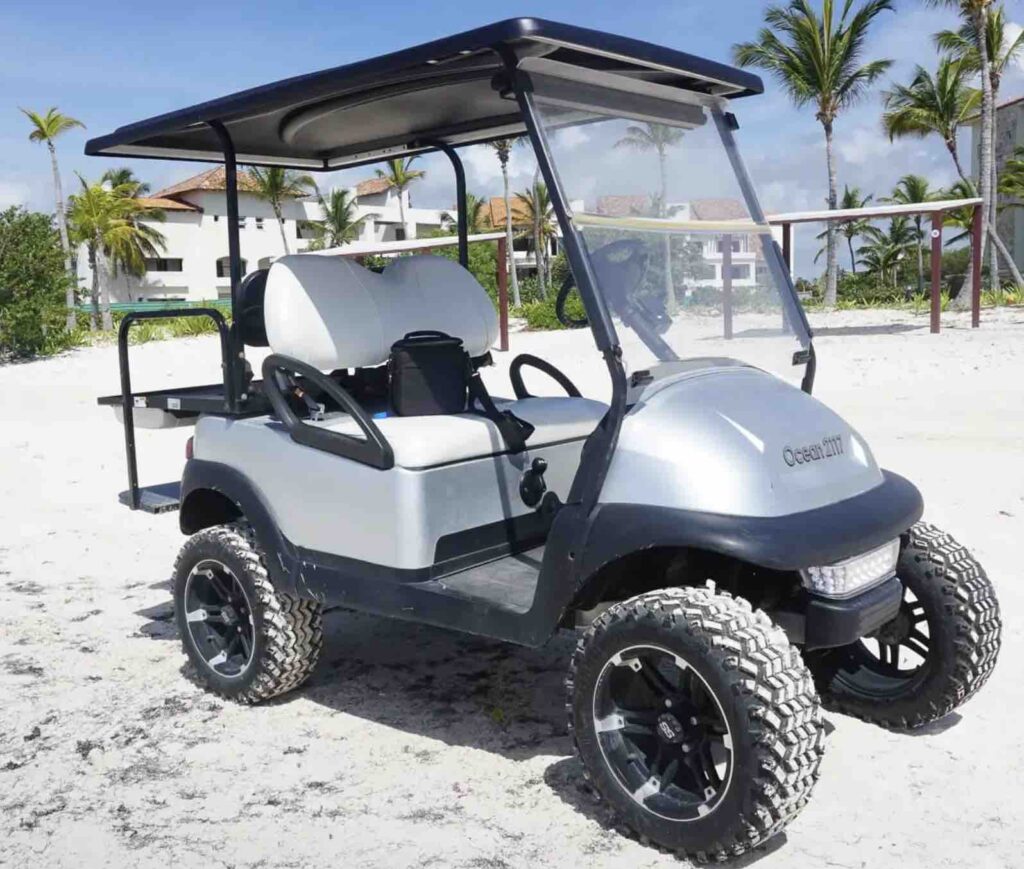Ruff and tuff golf carts are known for their durability and dependability, but even the toughest of machines can encounter some trouble from time to time. One common issue is when your golf cart is not firing, which can be caused by various factors. Another issue is locating fuses on a golf cart, as they can be hidden in different locations depending on the make and model. For gas golf carts, not firing can be caused by issues with the cart battery, faulty motor or solenoid, and fuse.
This is why this article will discuss troubleshooting techniques to help you identify and resolve each of the ruff and tuff golf cart troubleshooting signs you may notice.
And we will also address the following questions: Why is my golf cart not firing? Where are fuses on a golf cart? What would cause a gas golf cart not to fire? What are common problems with golf carts?.
So with that in mind, let’s get started with the first one why is my golf cart not firing?

Why is my golf cart not firing?
Common causes Why your golf cart may not be not firing can range from a dead battery, a faulty solenoid or controller, a malfunctioning ignition switch, a clogged fuel filter, or a bad spark plug to a bad ignition coil. And sometimes, it could be a problem with the carburetor or damaged electrical wiring. Start by taking a good look around and checking for any obvious issues, and if you can’t find the problem, don’t hesitate to call your mechanic.
What Are Common Ruff And Tuff Golf Cart Problems?
If you have wondered, What are common problems with golf carts? Well, here are some of the common ruff and tuff golf cart problems to look out for are:
- Direction Switch Problems
- Speed Controller Issues
- Faulty Solenoid
- Faulty Motor Or Ignition
Let’s explore these problems one by one below;
Ruff And Tuff Golf Cart Problems
1. Direction Switch Problems
The direction switch is responsible for your golf cart’s forward or reverse movement. It is the most used component of a golf cart. So, if it wears out over time, the switch would begin to act up.
2. Speed Controller Issues
If you start your golf cart without any issue, you cannot speed up as required or even maintain regular acceleration. There may be issues with the speed controller box. It could be that this box has cracked or has loose connections. So, fixing it is vital!
3. Faulty Solenoid
The solenoid is the main electrical switch in your golf cart. This electrical component allows current from the batteries to the motor. So, if it becomes faulty, your ruff and tuff golf cart will not start. Although, the cause of faulty solenoids includes; corrosion, loose wires, and broken coil.
Make sure you contact your certified mechanic to help solve this issue.
4. Faulty Motor Or Ignition
Suppose you have a charged battery but still have electrical issues in a golf cart. Check your golf’s ignition or motor immediately. It will be a risk if you don’t fix this issue.
Ruff and tuff golf cart troubleshooting
Step 1. Check the batteries.
1. The first step in ruff and tuff golf cart troubleshooting is ensuring the batteries are charged and properly connected. If the car battery is low or has died, your cart for sure will not have enough power to run. You will need to use a voltmeter to determine how much your battery has drained.
- Verify the age of your battery. Some cart models require very little electricity when they are not being used, especially when they are aged or old. This makes the battery unable to start if the cart is left without charging for long because they have lost all its life.
3. The water should be manageable to cover the conductive plates. If you feel adventurous, you can also add electrolytes to the battery of your electric golf cart. Wear gloves and protective eyewear and avoid any spills because batteries contain acid.
- Remove any corrosion. You can clean any corrosion with a soft brush, water, and baking soda. It is also a good time to inspect for frayed or broken wires.
Note: To prolong your battery’s life, ensure you fully charge your cart before each use. You’ll have a smooth ride, every time.
Step 2: Check the fuses
Next, you have checked the cart fuse and ensure they are not blown, and replace them if they are. A blown fuse can cause all sorts of problems for your cart; here is how you know if the fuse is the problem.
- So first, a burning or melting smell coming from the fuse box
- If the electrical components of your cart, like lights, horn, or speed controller, are also not functioning properly even before they refuse to start.
- When your golf cart experiences a loss of power or runs poorly, Or suddenly stops working while in use.
- If you experience any of these symptoms, it’s a good idea to check the fuses as a first step in troubleshooting. Keep in mind that a blown fuse can cause a variety of problems, so it’s important to check them before moving on to other potential issues.
- It’s also worth noting that, if you suspect a fuse is blown, you should turn off the golf cart and unplug it before checking the fuses.
How to identify a blown fuse
- To know when the fuse is blown, first locate the fuse box, but where are fuses on a golf cart? Well, the fuse boxes are typically located under the hood of your golf cart. Sometimes, behind a panel or cover.
- Once you’ve found the fuse box, please take a look inside and ensure they are not blown. A blown fuse will look dark or blackened, while a good one will be clear or have a small filament visible.
- If the fuse is blown, you will need to replace the blown fuse (see this video above). It’s always a good idea to carry a spare set of fuses with you when you’re out on the golf course, just in case.
- And finally, test the cart. Once you’ve replaced any blown fuses, turn on your golf cart and see if it runs like a charm. If it does, you’re good to go! If not, move on to the next step of troubleshooting.
Step 3. Motor or Ignition Issues
- If your electric golf cart is still not working after you have charged and cleaned it, you should check the motor.
- It may be as easy as pressing the reset button, believe it or not. To expose the motor, use a screwdriver. You will find a small button in the center of the main power supply. After pressing the button, your cart will be reassembled before you can charge it. This will often solve the problem.
- If the motor doesn’t work, remove it and test it with a fully charged, separate battery. If it doesn’t, the motor is likely to be dead.
- Motor burnout is usually caused by poor traction and excessive resistance to grade and weight. Uninstall the motor, and inspect it for worn brushes, damaged field coils, and damaged bearings.
- You may be able to repair the damage yourself if it is minor. You can always take your golf cart to a repair shop if you need the tools or patience.
- What happens if there is a problem with either the motor housing or the armature? These issues with electric golf carts are more complex to fix. It’s better to replace the motor rather than try to salvage what is left.
Step 4. Solenoid check
- A solenoid is a coil of wire that acts as an electric magnet. A solenoid can be used to power a switch. For example, the starter in your golf cart.
- You should hear a distinctive “clicking” sound as you turn the key. This sounds like a starter for a car. This solenoid provides the motor with the power it requires to move the cart.
- If your solenoid prevents you from starting your cart, it could be a problem with the motor. It could be a loose wire or broken coil if you are lucky. Sometimes, corrosion may also play a role.
- You can take your cart to a shop if you suspect the solenoid is defective. A mechanic can diagnose the problem and repair the solenoid if it persists.
Additionally signs to look out for when troubleshooting ruff and tuff golf cart
4. Faulty direction switch
- You put more wear and tear on the little direction switch every time you change your cart from forward or reverse.
- These switches can be used for many years before needing to be replaced. However, if your cart has been used for a long time or you have yet to drive it, you may experience problems with the direction switch. This is another repair that should be left to the professionals.
5. Speed Control is not available
- What if your cart doesn’t start up like it used to, but you don’t feel the same excitement?
- A faulty potentiometer could cause problems with your speed or slow down. It regulates the speed of your cart but is notoriously problematic over time.
- Cracks and loose connections are the two most common culprits. It can take time to identify the problem and fix it yourself. You won’t be able to reach the connectors and tighten them.
So I how this article on ruff and tuff golf cart troubleshooting and the common problems with golf carts has helped you. Please share this post if it helped.

Uchenna is a Radiographer and Auto parts mechanic who recently got his automotive diploma as an auto repair technician, and since then, has worked on fixing various car problems.
Working as just a radiographer, Uchenna didn’t just get all the fulfillment he desired, because he truly loved doing things tilted toward cars. As a kid, he would take apart his toy cars to see how they worked and would spend hours tinkering with his bike.
So, in 2017 he made the tough decision to become an auto mechanic. He threw himself into his studies and now loves every aspect of what he does.
He gets to work with his hands, solving problems and bringing cars back to life, and sharing his knowledge and easy quick-fix guide online are all part of what makes him feel fulfilled.

